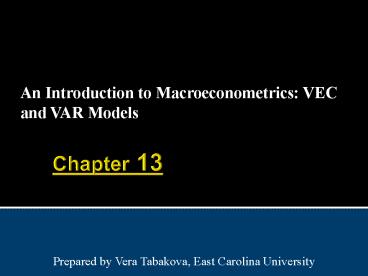An Introduction to Macroeconometrics: VEC and VAR Models - PowerPoint PPT Presentation
1 / 29
Title:
An Introduction to Macroeconometrics: VEC and VAR Models
Description:
13.4 Impulse Responses and Variance Decompositions ... Slide 13-28 (13A.1) Principles of Econometrics, 3rd Edition. Slide 13-29 (13A.2) ... – PowerPoint PPT presentation
Number of Views:610
Avg rating:3.0/5.0
Title: An Introduction to Macroeconometrics: VEC and VAR Models
1
Chapter 13
- An Introduction to Macroeconometrics VEC and VAR
Models
Prepared by Vera Tabakova, East Carolina
University
2
Chapter 13 An Introduction to Macroeconometrics
VEC and VAR Models
- 13.1 VEC and VAR Models
- 13.2 Estimating a Vector Error Correction model
- 13.3 Estimating a VAR Model
- 13.4 Impulse Responses and Variance
Decompositions
3
Chapter 13 An Introduction to Macroeconometrics
VEC and VAR Models
4
13.1 VEC and VAR Models
5
13.1 VEC and VAR Models
6
13.1 VEC and VAR Models
7
13.2 Estimating a Vector Error Correction Model
8
13.2.1 Example
- Figure 13.1 Real Gross Domestic Products (GDP)
9
13.2.1 Example
10
13.2.1 Example
11
13.3 Estimating a VAR Model
- Figure 13.2 Real GDP and the Consumer Price Index
(CPI)
12
13.3 Estimating a VAR Model
13
13.3 Estimating a VAR Model
14
13.4 Impulse Responses and Variance
Decompositions
- 13.4.1 Impulse Response Functions
- 13.4.1a The Univariate Case
- The series is subject it to a shock of size
? in period 1.
15
13.4.1a The Univariate Case
- Figure 13.3 Impulse Responses for an AR(1) model
(y .9y(1)e) following a unit shock
16
13.4.1b The Bivariate Case
17
13.4.1b The Bivariate Case
18
13.4.1b The Bivariate Case
19
13.4.1b The Bivariate Case
- Figure 13.4 Impulse Responses to Standard
Deviation Shock
20
13.4.2 Forecast Error Variance Decompositions
- 13.4.2a The Univariate Case
21
13.4.2 Forecast Error Variance Decompositions
- 13.4.2b The Bivariate Case
22
13.4.2 Forecast Error Variance Decompositions
- 13.4.2b The Bivariate Case
23
13.4.2 Forecast Error Variance Decompositions
- 13.4.2b The Bivariate Case
24
13.4.2 Forecast Error Variance Decompositions
- 13.4.2b The Bivariate Case
25
13.4.2 Forecast Error Variance Decompositions
- 13.4.2c The General Case
- The example above assumes that x and y are not
contemporaneously related and that the shocks are
uncorrelated. There is no identification problem
and the generation and interpretation of the
impulse response functions and decomposition of
the forecast error variance are straightforward.
In general, this is unlikely to be the case.
Contemporaneous interactions and correlated
errors complicate the identification of the
nature of shocks and hence the interpretation of
the impulses and decomposition of the causes of
the forecast error variance.
26
Keywords
- Dynamic relationships
- Error Correction
- Forecast Error Variance Decomposition
- Identification problem
- Impulse Response Functions
- VAR model
- VEC Model
27
Chapter 13 Appendix
- Appendix 13A The Identification Problem
28
Appendix 13A The Identification Problem
29
Appendix 13A The Identification Problem































